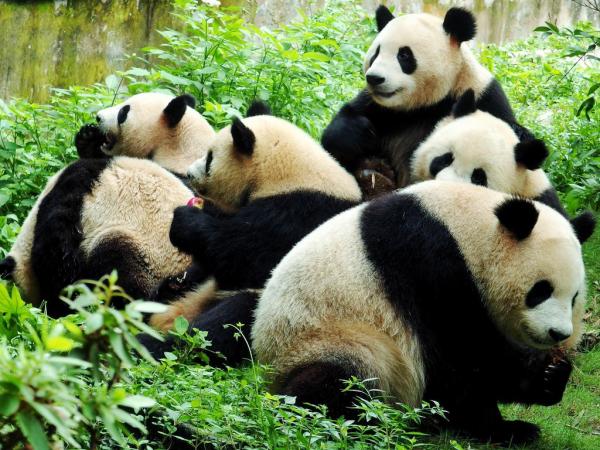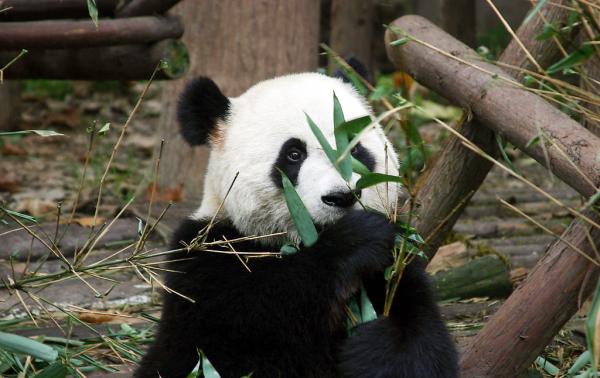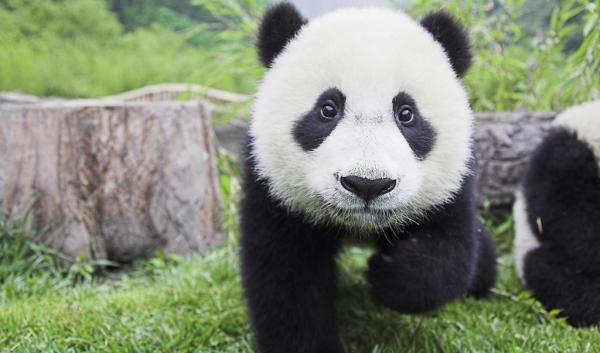Giant Panda
The giant panda has been living on the earth for at least 8 million years, known as a "living fossil" and "China's national treasure". It is the image ambassador of the World Wide Fund for Nature, and the flagship species of the world's biodiversity conservation. One of world’s most endangered species, giant panda can be found only in China. By January 2021, China's wild population of giant pandas had increased to 1,864.
Giant panda Facts
Giant panda scientific name: Ailuropoda melanoleuca
Chinese name: 大熊猫
French name: Panda géant
Spanish name: Panda Gigante
German name: Bambusbär, Großer Panda, Riesenpanda
Life span: 18-20 years ago, they can be over 30 years old in captivity
Distribution: Sichuan, Gansu, Shaanxi, China
History: over 8 million years

Giant panda appearance
The sharply contrasting black and white coloration, added to the stocky characteristic shape of a bear, makes the giant panda one of the most recognizable animals in the world. The head, top of the neck and rump are white, while small patches of fur around the eyes, the ears, shoulders, front legs, and rear legs are black. When compared with other bears, the head of the giant panda bear is large in relation to its body. The front paw has six digits as a result of the radial sesamoid, the wrist bone, becoming extended to form an awkward, but functional, opposable thumb. The male genitalia are small and pointed to the rear, which is more similar to the red panda (Ailurus fulgens) than to other bears.
Giant panda height and weight
How large is a giant panda? Adult giant pandas range in body length from about 160 to 190 centimeters (64 to 76 inches). Males are slightly longer than females, have stronger forelegs, and are 10 to 20 percent heavier. In the wild males weigh from 85 to 125 kilograms (190 to 275 pounds), while females range between 70 and 100 kilograms (155 to 220 pounds). At birth, cubs weigh only 85 to 140 grams (3 to 5 ounces).
Giant panda habitat
Giant pandas live at an altitude of between 1,200 and 3,500 meters (4,000 and 11,500 feet) in mountain forests that are characterized by dense stands of bamboo. Home ranges average 8.5 square kilometers (3.3 square miles) for ma les and 4.6 square kilometers (1.8 square miles) for females.
Panda bears are found only in western China, along the eastern edge of the Tibetan plateau. Although they were once more widespread, today the giant panda natural habitat is limited to six small areas in Sichuan, Gansu, and Shaanxi provinces, totaling only 14,000 square kilometers (5,400 square miles).
Giant panda ancestors
The ancestor of the giant panda is Ailuaractos lufengensis, one of the earliest carnivorous pandas that evolved from the bear-like species. The main cladon of the original panda continued to evolve in central and southern China, one of which appeared in the early Pleistocene about 3 million years ago. Its body size was smaller than that of the giant panda, and it could be inferred from its teeth that it had evolved into an omnivorous animal that also ate bamboo and gave birth to egg-bearing bears. Fossils are widely distributed in North China, Northwest China, East China, Southwest China, South China as well as Vietnam and northern Myanmar. Along the way, the giant pandas adapted to living in subtropical bamboo forests, growing in size and relying on bamboo for food. The giant panda bear reached its heyday in the middle and late Pleistocene, which was between 500,000 and 700,000 years ago.
Giant panda Diet
More than 99 percent of the food consumed by giant pandas consists of the branches, stems, and leaves of at least 30 species of bamboo, the species eaten varying from region to region. Adults consume 12 to 15 kilograms (26 to 33 pounds) of food per day when feeding on bamboo leaves and stems. However, when feeding on new bamboo shoots, they are capable of eating up to 38 kilograms (84 pounds) per day, which is about 40 percent of their average body weight. Although the proportion is small, pandas also feed to a limited degree on other plants and a small amount of meat. They feed mainly on the ground but are capable of climbing trees as well. Giant panda are active mainly at twilight and at night.

Reproduction
Pandas reach sexual maturity from four-and-a-half to six-and-a-half years of age. Giant panda mate during the spring, from March to May. Females are in estrus for one to three weeks, but peak receptiveness lasts for only a few days. Litters of one, two, or occasionally three cubs are born in August or September, usually in a hollow tree or cave. Normally, only one panda cub is raised. Although giant panda cubs are usually weaned at about nine months of age, they remain with their mothers for up to 18 months.
Giant panda cub
The newborn panda has a pink skin with sparse white fur. During the first few weeks of its life, giant panda mother will keep her cub in her arms, warming and protecting it, barely leaving her side, holding it in her mouth as she moves. In this respect, captive and wild pandas are the same. If a mother panda is licking her cub, it's likely she's helping her baby defecate. During the breeding period of giant pandas, the cries of cubs are very important communication tools for the connection between mothers and cubs. When the cubs want to eat milk, defecate, get cold or overheat or feel uncomfortable for other reasons, the cubs remind their mothers to meet their different needs through different cries. After 1 to 2 weeks, the black areas of the body begin to get darker. Within a month, a panda baby grows black ears, eye sockets, legs and shoulder straps, becoming more like their mother. When the cubs are 6 to 8 weeks old, they can open their eyes and start teething. After three months panda babies can crawl slowly.
In the wild, if giant panda twins are born (nearly 50 per cent of pandas give birth in captivity), a mother panda will often ignore or reject the weaker one, which ensures that at least one survives. In captivity, they are artificially reared and cub swapping techniques are used to try to keep all the cubs alive.
Giant panda social system
Except for females accompanied by cubs, giant pandas live a solitary existence. During the breeding season, several males may compete for access to a female. Home ranges of females are usually mutually exclusive, although they overlap occasionally, while the home range of each male may overlap those of several females. Pandas communicate by rubbing an acetic smelling substance-secreted by glands surrounding an genital area-onto tree trunks and stones. They also scratch trees. Most territorial marking is thought to be done by males. Pandas are quite vocal and eleven distinct calls have been identified in the wild, although the function of each is not understood. In captivity, females vocalize during estrus as well.
Top fun facts about giant panda
1. Giant pandas are good at climbing trees. Climbing trees is usually a way for the weak to avoid the strong when the time of marriage is approaching, or to escape danger, or to meet each other.
2. Apart from half of the time spent eating, pandas spend most of the other half in sleep. In the wild, giant pandas sleep for two to four hours between meals. Lying on their back, on their side, on their stomach, stretching or curled up are all their preferred ways of sleep.
3. Although seemingly bulky, giant pandas are actually very flexible and are able to position their bulky bodies in a variety of positions. Their favorite position is propping my legs up against a tree and covering my eyes with my hands.
4. Panda bear can be very naughty. They sometimes go down to the valleys and into the villages or houses. They treat pots, pans and buckets, especially round utensils, as toys and leave them in the mountains after playing.
5. Sometimes giant pandas are friendly with sheep, pigs and other domestic animals, and eat and live with them together.
6. On average, pandas poo 40 times a day. Surprise?!
7. Pandas are normally quite docile, but become very angry and fierce if their baby is in danger.
8. Giant panda is not a complete vegan, they like to eat bamboo rat. But to save energy, they eat bamboo most of the time and sometimes eat other vegetarian diet.
9. Female giant pandas are in estrus once a year, each time only 2-3 days. Estrus period is usually in March to May each year.

Best places to see pandas in China
■ Chengdu Research Base of Giant Panda Breeding
Situated on the Axe Hill 10 kilometers north of Chengdu, this 600-acre research station and breeding ground has been in operation since in 1987, opened to the public in early in 1995. 83 giant pandas as well as other endangered species like lesser pandas and black-necked crane currently reside at the base in quarters. There is also a semi-wild breeding area where China's animal ambassadors will be eventually be allowed to freely roam. Established in 1992, the museum has detailed exhibits on panda evolution, habits, habitats and conservation efforts.
It is the most ideal ecological tourism place for visitors all around world to get to know giant pandas and to get around the wild nature. It was awarded "Global 500" twice by the UN in the year of 1989 and 1994.
■ Dujiangyan Panda Base - China Panda Conservation and Research Center
Also known as the "Dujiangyan Panda Valley", Dujiangyan Panda Base borders the Taoist holy land of Mount Qingcheng to the north. Adjacent to the world heritage area of giant panda habitat, it has a suitable climate and natural environment for giant panda. By 2021, the base has 40 giant pandas, most of which are older than 25 and rescued from the wild.
Dujiangyan Panda Base is one of the best places to take panda volunteer program, with which you can be a honorary panda keeper to take care of one of world’s cutest animals.
>> Know more about giant panda volunteer program
■ Wolong China Giant Panda Garden – Shenshuping Base
Wolong panda base, with its 40 giant panda, has been moved to Shenshuping, after the 2008 earthquake. It is an essential part of giant panda natural habitat, featuring wild train areas for giant pandas, where the pandas will be released to the wild and live in the wild. At Wolong base, visitors can learn much knowledge of giant panda, see panda babies playing happily and freely in the trees, and become a panda nanny to help clean panda enclosures and feed pandas.
>> Explore our China panda keeper tours
■ Beijing Zoo
The Beijing Zoo was built in 1906 and opened to the public in 1908 with an area of about 10 hectares and a few humble pavilions to house the animals. Now the Beijing Zoo covers an area of about 50 hectares. The animal houses and enclosures, with a total floor space of 40,000 square meters, include those for pandas, elephants, brown and polar bears, tigers, hippopotami, rhinoceros, antelopes, giraffes and reptiles. More than 6,000 animals of over 500 species are on show.
The busiest area of the Beijing Zoo is the famous Panda House, home to giant and lesser pandas of China. It is located close to the south gate of the zoo. If you have never seen a panda bear, the Beijing Zoo is undoubtedly the best place to do it.
■ Fuzhou Panda World/ Research Center
Located in Fuzhou, the capital city of Fujian Province, Fuzhou Panda Research Center is a key research base for pandas in China, which has been engaged in spreading knowledge about pandas to the public for the past 20 years by organizing various educational activities. And it is also famous for its outstanding breakthroughs in scientific research programs, including the successful cloning of a panda embryo and the detection of some rare diseases of pandas. Besides, a cinema specializing in documentaries of giant pandas, allows the visitors to learn more about the beloved animal.